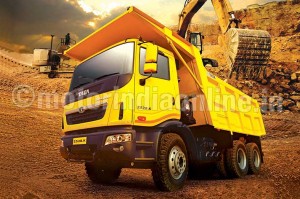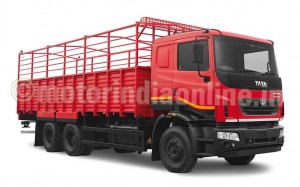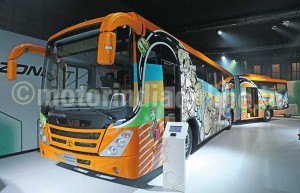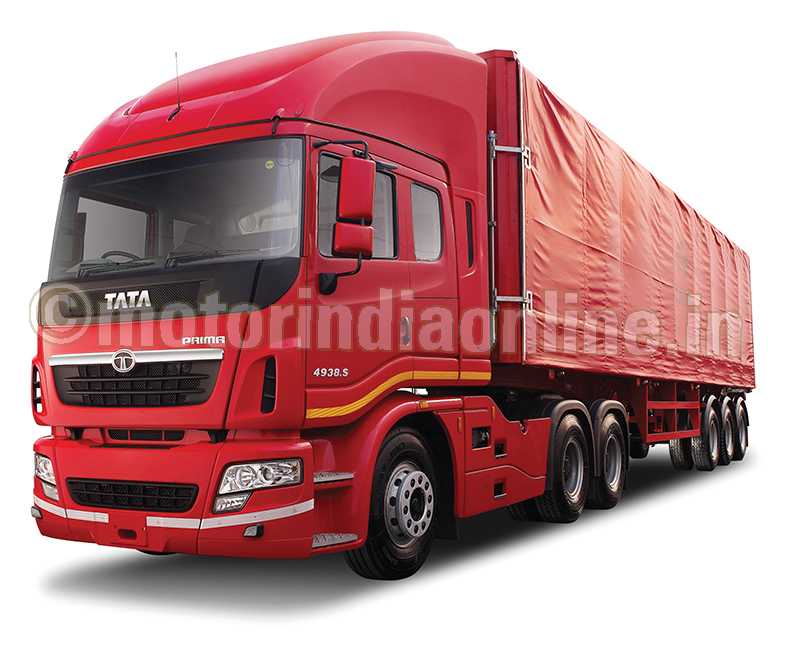 India’s GDP growth continued to be below five per cent and industrial growth remained in the negative territory. Consequently, the Indian auto industry witnessed a decline in both passenger vehicle and commercial vehicle segments by 4.7 per cent and 22.4 per cent respectively. For most of last year, the economy was hamstrung by rising inflation and high interest rates, leading to relatively low consumer interest in buying new vehicles and, in many cases, postponement of purchase. In the latter part of the year, reduction in excise duty and partial lifting of mining bans did help in recovery of sentiment, but only to a limited extent. High delinquencies in vehicle financing led to tightening of the lending norms by financiers, which badly impacted sales of small commercial vehicles and passenger cars.
India’s GDP growth continued to be below five per cent and industrial growth remained in the negative territory. Consequently, the Indian auto industry witnessed a decline in both passenger vehicle and commercial vehicle segments by 4.7 per cent and 22.4 per cent respectively. For most of last year, the economy was hamstrung by rising inflation and high interest rates, leading to relatively low consumer interest in buying new vehicles and, in many cases, postponement of purchase. In the latter part of the year, reduction in excise duty and partial lifting of mining bans did help in recovery of sentiment, but only to a limited extent. High delinquencies in vehicle financing led to tightening of the lending norms by financiers, which badly impacted sales of small commercial vehicles and passenger cars.
Despite the slowdown, Tata Motors, the country’s largest commercial vehicle maker, continued to battle the market, and also new competition, with revamped strategies, new products, upgraded technology, stepped-up service support, etc. Inevitably, Tata Motors’ domestic business lost market share in both commercial vehicle and passenger vehicle business. While the competition in both the segments remained quite aggressive with almost all the players resorting to huge discounting, Tata Motors’ approach was cautious and responsible. As an integral part of this approach, the company focused on keeping inventory levels low in order to reduce the burden on its channel partners.
Number crunching
Tata Motors Group sales for 2013-14 stood at 10,20,546 vehicles, lower by 14.4 per cent as compared to FY 2012-13. Global sales of all commercial vehicles were 432,600 units, while sales of passenger vehicles were at 587,946 units.
Tata Motors recorded sales of 569,677 vehicles, a decline of 30.2 per cent over FY 2012-13. Industry decline during the year was at 9.3 per cent, resulting in the company’s market share decreasing to 16.6 per cent in the Indian automotive industry from 22.1 per cent in the previous year. The company exported 49,922 vehicles, lower by two per cent as compared to FY 2012-13.
Within the domestic CV market, the company sold 3,77,909 vehicles in FY14, a decline of 29.5 per cent from FY 2012-13. This represented a market leadership share of 54.1 per cent in the domestic CV market which was mainly supported by consolidation in the M&HCV segment.
Products do the talking
On the product front, the company showcased several impressive new models at Auto Expo ’14, with a line-up that included the new Prima LX and Ultra range in commercial vehicles which offered great promise to be category leaders. They aptly demonstrate the company’s technological capabilities and its pursuit to offer world-class products and experience to its customers. To ensure its long-term competitiveness, the company also took several steps under the Horizonext strategy – new products, quality improvement and enhancement of the consumer experience – that will help improve sustainable profitability of the business in the long term. The company has steadily progressed in all these areas and is inculcating a culture which is intolerant to poor quality and absolutely committed to customer delight.
While the overall industry of M&HCV sales declined, Tata Motors was able to improve the market share by 1.6 per cent to stand at 54.9 per cent. A series of products were launched in this segment to augment the portfolio of product offerings and increase the market share. These included the Prima LX series of trucks – a perfect combination of economy and technology – 2523T, 3123T, 4028S (Single reduction and Hub reduction) and 4928S (Single reduction and Hub reduction), 4923.S LX, Prima 4938 Tractor, 3138K Tipper, LPT 3723 – India’s first 5-axle truck and LPK 3118, and Prima LX series of Tippers – 2523K, 3123K, 2528K and 3128K.
Tata Motors is working on new products and technologies keeping in view the changing market, customers’ aspirations and regulatory needs. The company is at an inflexion point with its entire product portfolio being revamped with relevant and exciting products for the target customers. Initiatives on cost-erosion and customer experience are being pursued with great rigour to help transform the organization into a more competitive and profitable business in the coming years.
Apart from product launches, Tata Motors also embarked upon other activities to stimulate market sentiments included in the pioneering T1 Prima Truck Racing Championship event as well as the successful value-added services, power of five campaign for trucks focusing on better KMPL, best vehicle uptime, highest resale value, best-in-class four-year warranty and lowest maintenance cost, as well as five powerful offerings – triple benefit insurance, increased oil change interval, four year AMC, Tata Alert, and Fleetman.
Bus segment performance
The bus segment also witnessed reversal in market share through intensive sales efforts coupled with the launch of buses with mechanical fuel injection pump (FIP), introduction of Starbus Ultra in Stage carriage, marketing initiatives such as ‘Humare Bus Ki Baat Hain’ and ‘Dream it to win it’ program.
The warranty for M&HCV buses and trucks were increased to three years and four years respectively, symbolizing improvement in quality. The ‘Tata Alert’ service, to return a vehicle back on road within 48 hours, has been expanded across all national highways.
The LCV segment, which registered good growth last year, did not continue its run this year. More specifically a decline in the SCV segment due to vehicle financing constraints was a major problem. Fund availability is the most critical element for the SCV segment. The high default rates in CV loans, coupled with early delinquencies, have instigated financiers to tighten the lending norms, reduce the (LTV) ratio with focus on collections impacted the SCV Cargo and SCV Passenger segments quite sharply. Some of the launches this year included the Ace and Magic DICOR and facelifts.
Tata Motors continued to outperform competition in terms of exports of CVs and enjoyed a total CV export share of 57 per cent in FY 2013-14. Shipments of M&HCV trucks grew by 34 per cent during the year, contributing significantly to the top line and the bottom line of the company. Shipments to the SAARC countries and RHD African countries, including South Africa, Kenya, Tanzania, Mozambique and Zambia, grew by six per cent and 12 per cent respectively. The opening of new markets in Australia and Indonesia made up for some of the shortfall in the Middle East and LHD African countries.
Overseas businesses
For Tata Daewoo Commercial Vehicles (TDCV), the company’s Korean arm, FY 2013-14 was a very encouraging as well as challenging year. On the one hand, domestic volumes increased by 21.9 per cent, resulting in strong performance of the TDCV as compared to its competitors, coupled with gradual recovery in the Korean economy. On the other hand, export volumes (including KD) decreased by 14.6 per cent as compared to the previous year mainly due to adverse economic conditions in global markets. TDCV’s total sales volume increased by five per cent in FY 2013-14 compared to FY 2012-13.
The total market for HCVs in Korea was almost stagnant during FY 2013-14 as compared to the previous year. However, TDCV achieved growth rate of 25.7 per cent with sales of 2,995 units of HCV in FY 2013-14 as compared to 2,383 units in the previous year. The medium duty trucks segment witnessed six per cent growth in FY 2013-14, mainly driven by gradual recovery of the Korean economy. In this segment also the company outperformed the industry by achieving 19 per cent volume growth with sales of 3,589 units as compared to 3,017 units in the previous year. TDCV was able to improve its market share in both HCV and MCV segments.
TDCV exported 4,016 units in FY 2013-14, down by 14.6 per cent as compared to 4,700 units sold in the previous year. Its sales decreased significantly in some of its traditional export markets like Russia, Laos, South Africa, Vietnam, etc. Sales in the previous year were high due to a few specific tenders (e.g., Kuwait, Iraq) which are not yearly requirement.
In Thailand, Tata Motors Thailand Ltd. (TMTL) sold 2,480 vehicles in the FY 2013-14, a year which saw the automotive market in the country drop over the previous year by almost 24 per cent. The Super Ace vehicles that are currently sold as CBU imports from India showed encouraging signs of acceptability in the market. TMTL continued to expand its dealer network in order to cover most of the provinces in the country. It also dispatched the first lot of test vehicles to Malaysia where regular exports of Xenon are planned beginning FY 2014-15.
Over to the African continent where Tata Motors (SA) (Pty) Ltd. (TMSA) sold 821 chassis in the South Africa market in FY 2013-14. TMSA homologated three new models in the LCV category, including a bus chassis LP713 for the first time. It also collaborated with TDCV to assemble a pilot lot of 6 chassis of a tractor truck model with the objective of expanding the TATA presence in the fastest growing (extra Heavy) segment of commercial vehicles in South Africa.
Indian market outlook
While the start of the new fiscal has continued with the moderate performance of last year, there is cautious optimism that FY 2014-15 would see the start of a revival in the global and domestic economies. The Indian economy is also expected to look up marginally, from a growth in GDP of five per cent in the last year.
Growth in the first half of FY 2014-15 is unlikely to be much different than in FY 2013-14 as the industrial and services sector growth is still weak. It is expected to be in the range of five per cent to 5.5 per cent. The new stable Government at the Centre will take steps to improve investor confidence that would lead to revival of economy in the second half of FY 2014-15. M&HCV truck sales, which are reflective of the economic sentiment, have seen an arrest in the declining trend at the start of the new fiscal. Infrastructure spending as well as regulation in areas like mining is expected to receive a positive shot in the arm.
In the background of pressure on volumes in India and limited headroom in pricing due to the intensely competitive market dynamics, the focus at Tata Motors will be on effective cost management, both direct and indirect, to maintain margins. Even in this challenging environment, as envisioned in the company’s mission statement, Tata Motors is looking to ‘passionately anticipate’ and provide vehicles and solutions that ‘excite customers globally’. The objective remains to be the ‘most admired’ company by all its stakeholders.
One of the key elements of this strategy would be to improve the relationship with the customer – the experience the customer has with the company at each touch point from sale to service and replacement sales experiences. This would include improving the physical look of the set-up and setting up of right processes and forums for speedy resolution of customer issues. The company will also actively pursue growth in the right international markets and look to consolidate its position in markets where it is already present.
The global economy is on the path of recovery, with consumer sentiment showing signs of improvement in all the major markets. The auto industry in India too, after one of its worst years, is seeing early signs of recovery and renewed confidence amongst consumers, particularly with the emergence of a stable government at the Centre. An industry turnaround is expected by the latter part of this financial year with the hope that the Government would also come out with policy interventions that support the growth of the auto industry, given its critical importance to development of the economy.
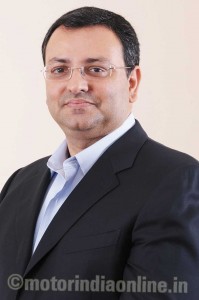
Both during the process of the market recovery and later on, Tata Motors will be ready and waiting for both competition and customers – to take out the former and enthral the latter – with its proven strategy and solutions, which have kept it on top of the Indian CV market for nearly six decades.
“Our employees, suppliers and channel partners remain our major source of strength. We sincerely thank them for their strong resolve and commitment shown to the cause of the company. Even in very difficult situations they have demonstrated utmost patience, understanding and dedication. I also wish to thank our shareholders, for reposing faith in Tata Motors and its management, without which the company could not have taken the bold steps and decisions required towards making Tata Motors a respected global automobile company”.
– Mr. Cyrus P. Mistry, Chairman, Tata Group
